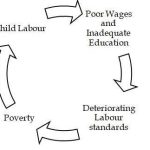
The National Commission for Scheduled Tribes says that a “scheduled tribe” is one that is “primitive,” “geographically isolated,” “shy,” and “socially, educationally, and economically backward.” These are the things that make Scheduled Tribe communities different from other communities in our country. The meaning of “Scheduled Tribes” has stayed the same since the 1931 Census, just like the definition of “Scheduled Castes,” which came from British laws.
According to the 2011 census, there are over 104 million tribal people, which is 8.6% of the total population of the country. The forest is very important to the culture and economy of the tribes. From birth to death, the forest has a lot to do with how the tribes live. Even though the law of India protects the tribal people, they are still the most backward group of people in India. Globalisation has many different aspects that sometimes help tribal groups and sometimes hurt them.
The National Commission for Scheduled Tribes says that there are more than 700 Scheduled Tribes in India. People who don’t know much about them often lump Scheduled Castes and Scheduled Tribes together, but they are very different. True, both groups have faced and still face a lot of abuse and marginalisation, both before and after India became independent. However, Scheduled Castes face social, educational, and economic isolation, while Scheduled Tribes are considered marginalised because they live in remote areas.
Table of Contents
What does “scheduled tribe” mean?
• According to the Census of 1931, “backward tribes” are Schedule tribes that live in “Excluded” and “Partially Excluded” places. The Government of India Act of 1935 was the first time that “backward tribes” were given the right to have members in provincial assemblies.
• The Constitution doesn’t say how Scheduled Tribes can be recognised, so the definition from the 1931 Census was used in the first few years after freedom.
• However, Article 366(25) of the Constitution only says how to define Scheduled Tribes: “Scheduled Tribes means such tribes or tribal communities or parts of or groups within such tribes or tribal communities as are deemed under Article 342 to be Scheduled Tribes for the purposes of this Constitution.”
Article 342(1) says that the President can designate as “Scheduled Tribes” the tribes or tribal communities, parts of tribes or tribal communities, or groups within tribes or tribal communities, in relation to any State or Union Territory. If it’s a State, this can only be done after consulting with the Governor.
Few Related Committees
• In 1965, the Lokur Committee was put together to look into how to define Schedule Tribes. The Committee came up with five ways to tell who was who: primitive traits, a unique culture, geographical isolation, a fear of touch with the rest of the world, and being behind the times.
• From 2002 to 2004, the Bhuria Commission looked at a wide range of problems, including the 5th Schedule, tribal land and forests, health and education, how Panchayats work, and the status of tribal women.
• In 2013, a High-Level Committee was set up under the leadership of Prof. Virginius Xaxa to study the five most important problems facing tribal communities. These issues are: (1) income and employment, (2) education, (3) health, (4) forced migration and displacement, and (5) legal and constitutional issues.
Various problems of tribal communities in India
• Resource exploitation:
The policy of liberalisation and the new state views on how to use resources are completely different from the adivasi worldview on how to use resources, and the market-oriented development theory of globalisation has only made this gap bigger.
Recent rapid technology growth and the unmatched economic and political power of world capitalism have made it easier for natural resources to be taken from tribal people’s lands, which are ecologically fragile, and for people to get away with it.
People aren’t allowed to use forests because of all the rules that exist about land, forests, small forest products, water resources, etc.
Villagers used to be able to get fuel, feed, and small forest products for free, but now they don’t have access to these things or have to pay to get them.
For the Tribals, globalisation means that prices are going up, jobs aren’t as safe, and there isn’t enough health care.
• Displacement:
Since liberalisation, privatisation, and globalisation (LPG) started, tribal people have been forced to move out of their homes, which has led to a number of protests.
So, forcing tribal people out of their homes to make room for huge development projects that require a lot of money has become a sad and growing trend.
• Problems with rehab:
There are holes in the process of rehabilitating people from tribal communities who have been moved because of development projects.
So far, only 21 million tribal people who were moved because of development projects and natural disasters have been moved back to their homes.
• Different problems in different places:
Health: For example, in the last two weeks, seven people from the KhariaSavar community died. Their life expectancy is about 26 years less than that of the average Indian.
o Almost 10% of the people in West Godavari District have Sickle Cell Anaemia.
Alienation: The problems in the Red Corridor, especially in Jharkhand, Odisha, and Madhya Pradesh, are poor government and incomplete land reforms, which have hurt the well-being of tribes.
Tribes in the North-East often fight among themselves over natural resources and who has the most land.
• Personal stakes:
In the name of helping poor indigenous tribal people improve their way of life, market forces have made money for themselves at the expense of the tribes’ way of life and safety.
• Unemployment:
In the central belt, there are a lot of industrial and mining operations going on. Even though there is a lot of economic activity in the central Indian tribal belt, there aren’t many tribal people working in modern businesses.
Aside from the Apprenticeship Act, there is no requirement for private or joint sector businesses to hire a certain number of tribal workers who have lost their homes.
They are pushed into a job market that keeps growing and is full of low-paying, unstable, temporary, and poor jobs.
About 40% of the tribal people in central India make extra money by working in this unfair and overly exploitative capitalism sector.
• Changes to social life:
Many more are slowly dying in their home country or in slums in cities. The future of their economy and culture is at risk.
The huge force of globalisation has made India’s poor even more vulnerable by making their social rejection worse and making large parts of tribal groups also vulnerable and left out.
• Led to moves below the national level:
A lot of “sub-national movements” like the ones in Jharkhand, Uttarakhand, and Bodoland have been caused by poor social and economic infrastructure in places that don’t have enough resources to take part in mainstream growth.
• Women from tribes:
Tribal forest economy is mostly run by women, and when corporations use their native lands for profit, women are the ones who feel it the most.
In tribal places where there is a lot of poverty, young women are moving to cities in search of work. This has been shown by large-scale migration.
Their living situations are dirty, they don’t make much money, and shady people can easily take advantage of them.
A lot of women in the groups have low red blood cell counts. As of March 31, 2015, all of India’s tribal areas were missing 6,796 sub-centres, 1,267 primary health centres (PHCs), and 309 community health centres (CHCs).
They are the ones who are most likely to be sexually abused by managers, bosses, and even other men who work on plantations.
• Jobs on the side:
With the influx of immigrant workers, mines, quarries, and industrial complexes were bad news for the local adivasi people.
• Cultural Defacement:
Tribes are being forced to become part of society, which means they are losing their unique traditional traits and their homes are in danger.
• Isolated tribes, like the Sentinelese, are still unfriendly to people from other places. In these situations, the government needs to enforce the “eyes on, hands off” strategy.
The Jarawa community is losing a lot of people because strangers are moving into the area. For example, the Andaman Trunk Road and other projects have cut through the Jarawa reserve.
• Nomadic, semi-nomadic, and denotified tribes have not yet been added to the list of Scheduled Tribes.
Their old jobs (like snake-charming and animal acrobatics on the street) are now illegal, and they don’t have any other choices.
• Some tribes have been given the name “Particularly Vulnerable Tribal Groups” (PVTGs), which used to be called “Primitive Tribal Groups,” because they are more “vulnerable” than other tribes. India has 75 of these kinds of tribes.
Constitutional Safeguards for STs
Educational & Cultural Safeguards
• Article 15(4): Special rules for the advancement of STs and other backward groups;
• Article 29: Protection of Minorities’ Interests, which includes STs;
• Article 46: “The State shall promote with special care the educational and economic interests of the weaker sections of the people, especially the Scheduled Castes and the Scheduled Tribes, and shall protect them from social injustice and all forms of exploitation.”
• Article 350: Right to keep a language, script, or culture separate;
• Article 350: Teaching in the native language.
Social Safeguard
• Article 23: Prohibition of trafficking in people and begging, as well as other forms of forced labour that are related;
• Article 24: It’s against the law for kids to work.
Economic Safeguards
• Article 244: Clause (1) The provisions of the Fifth Schedule apply to the governance and control of Scheduled Areas and Scheduled Tribes in any State other than Assam, Meghalaya, Mizoram, and Tripura, which are covered by the Sixth Schedule. Clause (2) of this Article says that the Sixth Schedule applies to Assam, Meghalaya, Mizoram, and Tripura.
• Article 275: Grants-in-Aid to certain States (STs and SAs) covered by the Constitution’s Fifth and Sixth Schedules.
Political Safeguards
• Article 164(1): Gives Bihar, MP, and Orissa ministers in charge of tribal affairs;
• Article 330: Set aside places in the Lok Sabha for STs;
• Article 337: Set aside places in state legislatures for STs;
• Article 334: 10 years to make an appointment (this time frame has been changed several times to make it longer);
• Article 243: Seats in Panchayats Can Be Saved.
• Article 371: Special rules for the Northeastern States and Sikkim
Safeguards for Service
• (Under Art.16(4),16(4A),164(B) Art.335, and Art. 320(40
Article 338A tells the government to set up a National Commission for Scheduled Tribes to make sure that the rights of Scheduled Tribes in India are protected and that the laws are followed.
The Constitution’s Fifth Schedule
• It lays out the rules for running Scheduled areas and makes sure that Tribes Advisory Councils are set up in states with Scheduled Tribes but no Scheduled Areas. The council’s job is to help the tribes with their welfare and progress.
The Constitution’s Sixth Schedule
• Article 244 of Part X of the Constitution says that there will be a special way to run some areas called “scheduled areas” and “tribal areas.” The Sixth Schedule of the Constitution says how the tribal areas in the four north-eastern states of Assam, Meghalaya, Tripura, and Mizoram will be run.
Legislative measures
Aside from the protections in the Constitution, the law also gives Scheduled Tribes other rights to protect their geographical interests, such as protecting forest lands.
• The Scheduled Castes and Scheduled Tribes (Prevention of Atrocities) Act of 1989 and the Rules made under it in 1995.
• The Bonded Labour System (Abolition) Act of 1976, which ended forced labour for the Scheduled Tribes;
• The Child Labour (Prohibition and Regulation) Act of 1986;
• State laws and rules about selling or giving back land that belongs to STs;
• Act of 1980 to protect forests;
• The Panchayatiraj (Extension to Scheduled Areas) Act of 1996;
• The Minimum Wage Act from 1948.
• The Scheduled Castes and Scheduled Tribes (Prevention of Atrocities) Amendment Act of 2015
• The Scheduled Tribes and Other Traditional Forest Dwellers (Recognition of Forest Rights) Act of 2006
Government Initiatives for ST
Pradhan Mantri Van Dhan Yojana (PMVDY) is a Market-Linked Tribal Entrepreneurship Development Programme. It aims to form clusters of tribal SHGs and develop them so that they can become Tribal Producer Companies. All 27 states in the country are taking part.
• It tries to raise the incomes of tribes by adding value to their goods.
• Increasing the income of the tribal population: Minor Forest Products (MFP) are one of the main ways that tribal people who live in forest areas make a living.
About 100 million people who live in forests rely on MFPs for food, shelter, medicine, and cash income. This shows how important MFPs are to this group of people.
It gives them important food during the lean times, especially for primitive tribe groups like hunter-gatherers and people without land.
20–40% of a tribe’s total income comes from MFP, which is also where they spend most of their time.
• Women’s Financial Independence: Most of the MFPs are collected, used, or sold by women, so this activity has a strong link to women’s financial independence.
• Employment: The MFP sector could bring about 10 million workdays in the country every year.
• The scheme’s main way to raise the incomes of tribal people would be to add three stages of value.
It is planned that the purchasing at the local level will be done by Self Help Groups that are part of the operating agencies.
Convergence and networking with other government agencies. There should be a plan or department set up to use the services of SHGs like Ajeevika, etc.
These SHGs will get the right training on sustainable harvesting/collection, primary processing, and adding value. They will also be put into groups so that they can combine their stocks into a size that can be sold, and they will be linked to a Van Dhan Vikas Kendra that has facilities for primary processing.
• Building Capacity: Under Van Dhan, 10 Self-Help Groups made up of 30 Tribal gatherers. The “Van Dhan Vikas Kendra” is being set up to help people improve their skills and build their abilities, as well as to set up facilities for basic processing and adding value.
Working with Collector as their boss, these groups can then sell their goods both inside and outside of the United States. TRIFED is in charge of training and technical help.
It is planned to build 3,000 of these sites across the country.
• The Van Dhan Vikas Kendras will be a big step in the economic development of tribal people who collect MFPs by helping them make the best use of natural resources and giving them a sustainable way to make a living from MFPs in MFP-rich areas.
Way forward for ST
• The High-Level Committee (Virginius Xaxa Committee) has made many suggestions, such as giving tribal people exclusive mining rights, giving tribal people more freedom to make decisions about land acquisition and other common property resources, and making sure that the new land law, the Forest Rights Act, and the PESA are strictly followed.
• It has also suggested a full change to the legal constitutional system by saying that laws and policies made by Parliament and state legislatures shouldn’t automatically apply to the Fifth Schedule areas.
• The state government should be required to get permission from landowners and people living on the land for big minerals, and the gramme Sabha should be consulted for minor minerals in the 5th and 6th schedule areas.
• The Forest Conservation Act and the Wildlife Protection Act should require that all clearances (for the forest and the environment) be taken before a lease is given.
• Small minerals should be licenced to tribal groups in the 5th and 6th schedule areas.
Even though these recommendations are good, the lack of political will to adopt them, especially in light of the current government’s increased push for industrialization, could be a big problem. The government should make sure that the distorted and overly exploitative capitalist sector doesn’t end up performing ethnocide by putting their economic and cultural survival at risk.
















